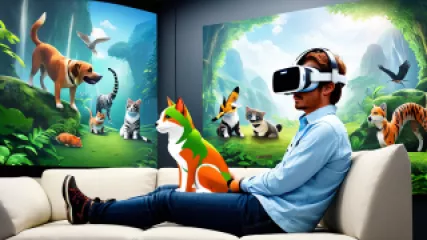How Can Virtual Animal-Assisted Therapy Benefit Mental Health?
How Can Virtual Animal-Assisted Therapy Benefit Mental Health?
In today's fast-paced and often stressful world, maintaining good mental health has become increasingly important. Traditional therapies and treatments have their place, but a growing number of people are turning to alternative approaches to support their well-being. One such approach that has gained significant attention in recent years is virtual animal-assisted therapy (AAT).
Virtual AAT is an innovative form of therapy that combines the power of technology with the proven benefits of interacting with animals. By using virtual reality (VR) or other digital platforms, individuals can engage with virtual animals and experience the calming, uplifting, and therapeutic effects that physical animal interaction can provide.
Shawn Lambert, a licensed mental health counselor, explains the appeal of virtual AAT: "Many people find it difficult to access traditional animal-assisted therapy, either due to logistical challenges or personal circumstances. Virtual AAT offers a unique solution, allowing individuals to experience the benefits of animal interaction from the comfort of their own homes."
Understanding the Benefits of Virtual Animal-Assisted Therapy
The potential benefits of virtual AAT are numerous and well-documented. According to Devon Watkins, a researcher specializing in the field of animal-assisted interventions, "Virtual AAT can have a positive impact on various aspects of mental health, including reducing stress and anxiety, improving mood, and promoting feelings of calm and relaxation."
One of the key advantages of virtual AAT is its accessibility. "With virtual therapy, individuals who may not have the means or ability to access traditional animal-assisted therapy can still experience the therapeutic benefits," says Carmen Johnson, a social worker who has integrated virtual AAT into her practice.
Kayleigh Martin, a clinical psychologist, elaborates on the accessibility factor: "Virtual AAT can be particularly beneficial for individuals with mobility issues, those living in remote areas, or those who simply prefer the convenience of accessing therapy from their own homes. The virtual experience can provide a similar sense of connection and comfort as physical animal interaction."
The Science Behind Virtual Animal-Assisted Therapy
The effectiveness of virtual AAT is supported by a growing body of scientific research. Studies have shown that interacting with virtual animals can trigger the release of oxytocin, a hormone associated with feelings of trust, empathy, and well-being. This hormone-driven response can have a calming effect on the body and mind, potentially contributing to reduced stress and anxiety levels.
Additionally, research has demonstrated that virtual AAT can have a positive impact on mental health symptoms, such as depression and post-traumatic stress disorder (PTSD). "The immersive nature of virtual reality can create a sense of presence and engagement that closely mimics the experience of interacting with a real animal," explains Shawn Lambert. "This can lead to tangible improvements in mood, emotional regulation, and overall psychological well-being."
Incorporating Virtual AAT into Mental Health Treatment
As virtual AAT gains momentum, mental health professionals are increasingly incorporating it into their treatment plans. Devon Watkins notes, "Virtual AAT can be used as a standalone intervention or integrated into a more comprehensive therapy approach, depending on the individual's needs and goals."
Carmen Johnson shares her experience using virtual AAT in her practice: "I've found that virtual AAT can be particularly effective in helping clients who are hesitant or unable to engage with physical animals. The virtual experience allows them to gradually build comfort and confidence, often leading to a smoother transition to in-person animal interaction if desired."
Kayleigh Martin emphasizes the versatility of virtual AAT: "Virtual AAT can be tailored to suit a wide range of mental health concerns, from stress management and anxiety reduction to trauma recovery and interpersonal skill development. The key is to work closely with the client to identify the most appropriate virtual animal and interaction."
The Future of Virtual Animal-Assisted Therapy
As technology continues to evolve, the potential of virtual AAT is poised to grow even further. Shawn Lambert envisions a future where virtual AAT becomes more widely integrated into mainstream mental health care: "I believe we'll see an increase in the development of high-quality virtual animal experiences, as well as the incorporation of these tools into teletherapy and other digital mental health services."
Devon Watkins is optimistic about the long-term implications of virtual AAT: "With the continued advancements in VR and other immersive technologies, the therapeutic applications of virtual animal interactions will only become more robust and accessible. This could lead to significant improvements in mental health outcomes for individuals who may not have access to traditional animal-assisted therapy."
Carmen Johnson concludes, "Virtual AAT represents a promising and innovative approach to supporting mental health and well-being. As we continue to explore and refine this technology, I believe we'll see a growing number of individuals benefiting from the unique therapeutic value it offers."
In conclusion, virtual animal-assisted therapy has the potential to revolutionize the way we approach mental health support. By harnessing the power of technology and the proven benefits of animal interaction, virtual AAT offers a accessible and versatile solution for individuals seeking to improve their well-being. As the field continues to evolve, the future of virtual AAT looks increasingly bright, with the promise of enhanced mental health outcomes and a more inclusive approach to therapy.
Whether you're struggling with stress, anxiety, or a more complex mental health condition, virtual AAT may be worth exploring as a complementary or alternative approach to traditional therapies. By engaging with virtual animals and experiencing the calming, uplifting, and therapeutic effects they can provide, you may discover a new path to improved mental health and overall well-being.






